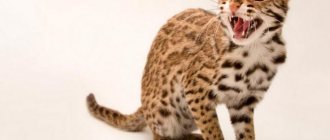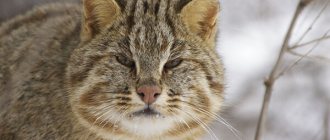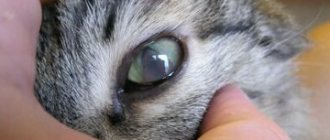01 March57373wild catsmanulpredatorPallas cat
The wild cat Manul is a predatory representative of small cats from the Felidae family. Manul is an interesting and unusual animal. The manul cat is smart, careful and secretive. The Pallas cat is also called the Pallas cat. In this article you will find a description of the Pallas's cat and its photo, and you can also learn a lot of interesting things about the amazing animal with the mysterious name Pallas's cat.
Manul: description of the breed, structure, characteristics. What does a manul look like?
In appearance, the manul cat is very similar to an ordinary domestic cat, only much larger and fluffier. And unlike the domestic cat, the manul cannot live in captivity at all. The body length of the Pallas's cat is 50-65 cm, and its long tail is also up to 30 cm. The average weight of a Pallas's cat is 5 kg.
The long and incredibly thick fur of the Pallas's cat is his calling card; the length of his coat reaches 7 cm. It is the Pallas's cat that has the thickest fur among all representatives of the cat family.
The head of the Pallas' cat is slightly flattened, the ears are small and widely set. This head structure gives scientists grounds to assume that the manul cat is a distant relative of the Persian cat.
One can note the rather angry, stern appearance of the Pallas's cat; this severity of his appearance is due to the peculiar “sideburns” on his cheeks, formed by tufts of long hair.
The expressive eyes of the Pallas's cat are yellow. Unlike a domestic cat, this cat's pupils do not constrict in bright light, but always remain round.
As for the color of the Pallas' cat, usually the color of its coat is combined and is represented by the color scheme of light gray and yellow-brown. At the same time, the tips of its fur are painted white, and it seems as if the Pallas's cat is lightly dusted with snow.
Like any decent cat, the Pallas cat has sharp claws and teeth.
The manul cat was first discovered only in the 18th century by the German naturalist Peter Palas, who conducted research on the coast of the Caspian Sea. Thanks to the scientist, this wild cat became known to the general public.
[edit] Links
Pet the cat, bitch! You will see the elephant Mirounga Leonina
- ru_manulomania
- This is where the Pallas's cat lives and here you can pet him
- Archive
| [ + ] “Pallas cat” - Buzzing meme. Visit the Blogosphere portal for more detailed information. | |||||||||||
| |||||||||||
| [ + ] Who said ? Manul! | |||||
| |||||
Where does the manul live?
Pallas' cats live in Central and Central Asia and are also found in Eastern Europe. In particular, one of the subspecies of Pallas's cat lives in Russia: in the Krasnoyarsk Territory, the Altai Republic, Transbaikalia and Tuva. Pallas' cats can also be found in the steppes of Uzbekistan, Tajikistan, Iran, Pakistan, and Afghanistan. And so the so-called Tibetan Pallas's cat lives in the mountains of Nepal and Tibet itself.
As habitats, Pallas's cats prefer steppe areas with low-growing grass and shrubs.
Lifestyle of Pallas's cat
Pallas' cats lead a sedentary and solitary lifestyle. These are territorial animals, each cat has its own “domain”, the boundaries of which are marked with urine. If his territory is violated by another cat, a fight is possible between them. Although, in general, Pallas' cats, despite their harsh appearance, are peaceful animals.
During the day, as well as at night, Pallas' cats usually sleep, hiding in a secluded shelter under stones or in old burrows of other animals (usually marmots,
foxed badgers). And in the evening and in the morning they have hunting time. And here we move on to the next point.
Everyday life
Pallas' cats are found in open spaces. They live alone and hunt at night, like most predators. His hunting target is all kinds of rodents. The manul is very slow in its movements and is rarely able to catch up with its prey. Having finished the hunt, the cat prefers to rest in a dwelling, often located in rock gorges or in other people's burrows. He sees females exclusively during the breeding season.
60 days after mating, the female brings offspring - kittens. As a rule, she gives birth to about six kittens. Their weight is about 250 grams, the average length is 12 centimeters. When kittens are 3 or 4 months old, they become hunters. After reaching the age of ten months, the kittens, already adults, leave their mother. Their lifespan is approximately 12 years.
What does manul eat?
Like all representatives of the cat family, manulas are true predators. The usual food of these animals is various field rodents, gophers, marmots, hares, and small birds.
Being the most clumsy and slow among cats, manuls, however, have excellent vision, hearing and smell, which they actively use during hunting. Pallas' cats catch their prey by cunning; they usually guard it in ambush, hiding near the stones. The color of the Pallas's cat serves as a kind of camouflage and allows it to remain unnoticed. After a potential victim appears on the horizon, the Pallas cat makes a sharp jerk and grabs the “lunch” with its sharp claws. If a mouse or gopher managed to escape, then the Pallas's cat will not continue to pursue its prey, since they do not run very fast. It’s easier for them to ambush new “food” again.
Hunting and food
Manul is endowed with patience. When hunting, he does not rush, but calmly waits for his prey in ambush. The predator guards near the hole and attacks from the back.
Be sure to read:
A cat that looks like a lynx: the best domestic and exotic breeds, features of their maintenance
Cats hunt Daurian peeps and small rodents . Animals feed on hares, marmots, and birds. If the hunt is unsuccessful, the cat will be satisfied with prey such as insects. The animal eats plants and berries.
A predator attacks at night. In the warm spring and summer, the cave cat loves to bask in the sun, so it hunts during the day.
In zoos, pets are fed rodents and beef.
Enemies of Pallas's cat
In natural conditions, the Pallas's cat has practically no enemies. Only flocks pose a certain danger
Wolves are large birds of prey. Being cautious animals, Pallas' cats will rarely engage in combat, preferring, in case of danger, to flee and hide in a secluded place. An exception may be the moment when the Pallas's cat is taken by surprise and driven into a dead end. Then he will begin to growl menacingly and bare his sharp teeth.
Character and behavior of the Pallas's cat
The character and behavior of this wild cat is determined by its lifestyle and slowness. The manul is an extremely cautious animal; rushing somewhere headlong is not for him. In general, Pallas' cats are very phlegmatic creatures, being active only in the morning and evening (their hunting time), the rest of the time they will be lethargic and inactive.
Also, the Pallas's cat is a kind of hermit; he does not like the company of his own kind, and even more so the company of a person whom he also tries to avoid. His gloomy, reclusive character was the reason for his failures in attempts to tame this cat. We will talk about the possible keeping of Pallas' cat at home below.
Types of Pallas' cat, photos and names
There are 3 types of manuls and below we will describe them in more detail.
Pallas's cat
He is also a Siberian Pallas' cat. It lives on the territory of the Russian Federation - in Siberia, in the Krasnoyarsk Territory, the Altai Republic, in Transbaikalia and Tuva. It can also be found in Mongolia and China. It was this manul that was first discovered and described by zoologist Peter Pallas. It has a predominant light gray color.
Central Asian manul
It lives in a number of Asian countries: Uzbekistan, Iran, Turkmenistan, Afghanistan. It differs from the Siberian Pallas's cat in its reddish-brown color.
Tibetan Pallas's cat
It has darker fur, which takes on a characteristic silver tint in winter. Lives in the mountains of Nepal and Tibet.
Reproduction of Pallas's cat
The only reason when these hermit cats, Pallas's cats, do get together is for procreation. Their mating season begins in late February - early March, at which time males begin to look for a mate for mating.
It’s funny that just before “this thing” itself, males can gallantly court their tailed “lady” - throw food gifts at her paws and ferociously drive away other potential competitors. However, courtship does not last long, due to the short estrus in females, males need to have time to conceive children within a few days, if this does not happen, then pregnancy can no longer be expected this year.
Having done the job, the males leave, leaving all worries about the future kittens to the female. The pregnancy of a Pallas cat lasts 60 days; towards the end of this period, she looks for a secluded place where blind and helpless kittens are born. From 2 to 6 kittens are born at a time.
Pallas cat kittens weigh only 200-300 grams at birth. They are completely helpless and are under the full care of their mother. The mother manul takes care of her babies, feeds them with her breast milk, teaches them to walk, hide, and then hunt. By the way, manula kittens go on their first hunt by the age of 3 months, and at the 10th month of life they become sexually mature adult cats, after which they leave their mother.
Interesting facts about Manul
Pallas's cat is one of the most unique animals on Earth, which has managed to survive unchanged for millions of years.
This is one of the most popular cats, living in many world reserves and zoos.
Due to his difficult, quarrelsome character, the Manul is often called a lonely steppe warrior.
Despite its nocturnal lifestyle, in spring and summer Pallas's cat loves to bask in the sun and gets out of its den during the day.
Manul does not know how to meow or purr. Even small kittens only hiss and snort, and communicate with each other using rough, hoarse sounds that are more reminiscent of “wow” rather than “meow.”
It was Manul who, during the online voting for the title of candidate for the symbol of the Moscow Zoo, received the largest number of votes and became the mascot.
The interesting appearance of the animal made its image very popular - many postage stamps were issued from Tajikistan, Azerbaijan, Mongolia, Kyrgyzstan and even the UN and Benin.
Many countries have issued silver coins with the image of this exotic beast.
Manul at home
Despite the fact that the Pallas' cat is extremely difficult to tame, there are exotic lovers who still risk getting a pet Pallas's cat. This is exactly what is at risk, since at home the Pallas's cat will behave wildly and unpredictably; if you try to pet it, it can easily scratch or bite. And you should definitely prepare for scratched furniture and torn wallpaper.
Also, the immunity of Pallas's cats kept in captivity deteriorates, they often begin to get sick, as if their very nature protests and demands a return to their native and wild steppes. Therefore, we highly recommend not keeping Pallas's cat at home.
Health issues
A problem that has long been known in zoos is the high susceptibility of Pallas’s cats, especially their kittens, to various infectious diseases. In the wild, each animal lives alone, avoids contact with its own kind and does not meet with domestic cats.
In captivity, the immune system of cats does not always cope with many bacteria. Pallas' cats are especially often affected by toxoplasmosis, a dangerous parasitic disease that can be transmitted to humans.
The lifespan of Pallas's cat in the wild is up to 12 years, in zoos up to 18 years.











